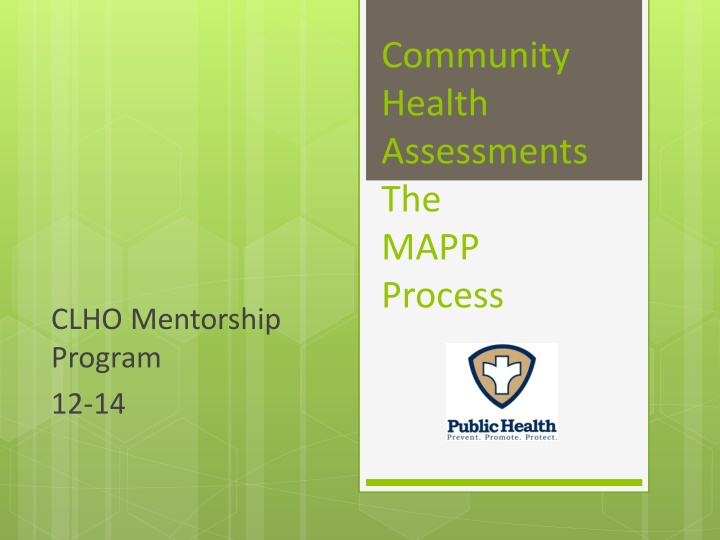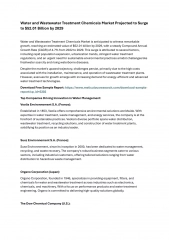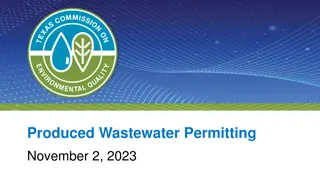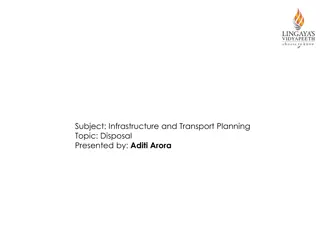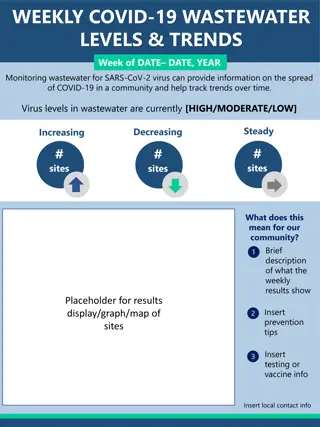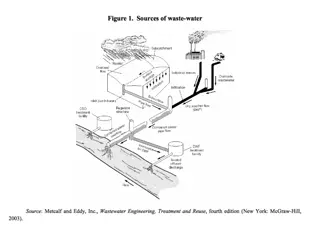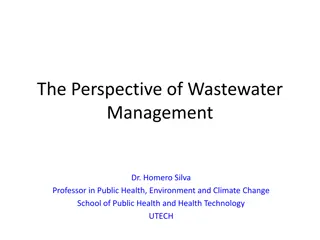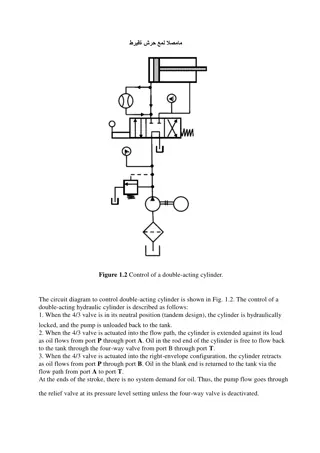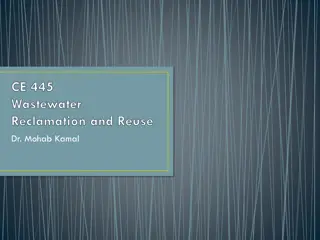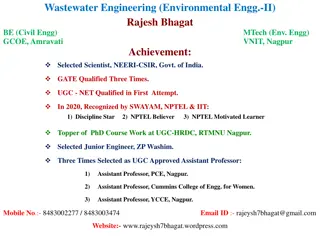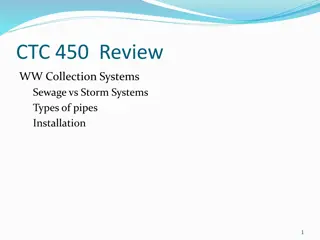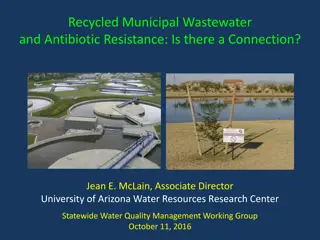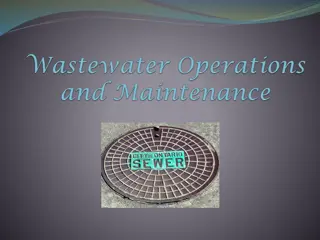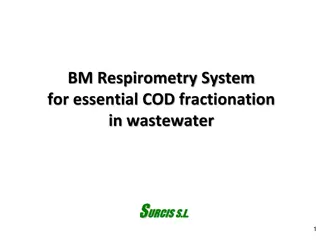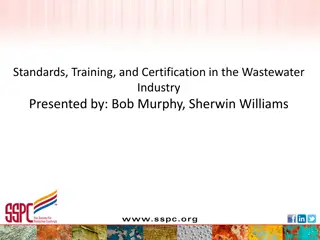Wastewater and Hydraulic Principles
In this informative content, various concepts related to wastewater hydraulics, weight and volume calculations for water, force and pressure relationships, different types of heads in fluid systems, flow and discharge rates, piezometric surface, hydraulic machines (pumps), and pumping hydraulics are discussed. The content delves into how energy is managed in hydraulic systems, the operation of pumps, and the factors influencing dynamic and static heads in fluid flow. Each topic is explained concisely with relevant equations and examples, providing a comprehensive overview of essential hydraulic principles.
Uploaded on Apr 13, 2025 | 0 Views
Download Presentation

Please find below an Image/Link to download the presentation.
The content on the website is provided AS IS for your information and personal use only. It may not be sold, licensed, or shared on other websites without obtaining consent from the author.If you encounter any issues during the download, it is possible that the publisher has removed the file from their server.
You are allowed to download the files provided on this website for personal or commercial use, subject to the condition that they are used lawfully. All files are the property of their respective owners.
The content on the website is provided AS IS for your information and personal use only. It may not be sold, licensed, or shared on other websites without obtaining consent from the author.
E N D
Presentation Transcript
Community Health Assessments The MAPP Process CLHO Mentorship Program 12-14
OUTLINE Community Assessment CHA/CHIP is Required The MAPP Model What is MAPP? Benefits Elements of the process MAPP Framework & Phases How does it work? Resources & Information
CCO Requirements OAR 410-141-3145 Conduct every 3 years Must engage representatives of the critical populations and community stakeholders to create a plan for addressing community health needs that build on community resources and skills and emphasized innovation.
Local Public Health and Behavioral Health Requirements Core Public Health function/ Essential Service Public Health Accreditation Board Conduct every 5 years Participate in or conduct a collaborative process resulting in a comprehensive community health assessment Behavioral Health Required by Oregon Health Authority Collaborative process resulting in a comprehensive community health assessment Led by the Tri-County Mental Health in coordination with Public Health
Community Benefit Requirements Patient Protection & Affordable Care Act via IRS form 990H requires non- profit hospitals to conduct a community health needs assessment and adopt an implementation strategy to meet identified community health needs Must take into account input from those with expertise in public health Conduct every 3 years Identify and assess health needs of the community served Healthy People 2020-NACCHO Partnership, National Association of County and City Health Officials, http://www.naccho.org/healthypeople (2012)
Community Health Assessments Learn about the health status of the community Identify areas for health improvement Implement community plans to work toward improved health outcomes Collaborative process-- Opportunity to work with a broad range of community partners
What is MAPP? MAPP provides: a framework, guidance, structure, and best practices MAPP is: A community-wide strategic planning process for improving health A method to help communities prioritize public health issues, identify resources for addressing them and take action
Elements of MAPP Community-driven, community-owned approach Builds on previous experiences and lessons learned Uses traditional strategic planning concepts within its model Focuses on the creation and strengthening of the Local Public Health System (Health Care System) Brings four assessments together to drive the development of a community strategic plan
Benefits of MAPP Create a healthy community and a better quality of life Increase the visibility/infrastructure of public health within the community Anticipate and manage change
Benefits of MAPP Community strategic planning better prepares local public health systems to anticipate, manage, and respond to changes in the environment Engage the community and create community ownership for public health issues Build stronger partnerships
Three Keys to MAPP Focus on the Local Public Health System Strategic Thinking Community Driven Process
MAPP PHASES Phase 1: Organize for success/ partnership development Phase 2: Visioning Phase 3: The four MAPP Assessments Community Themes & Strengths Assessment Community Health Status Assessment Local Public Health System Assessment Forces of Change Assessment Phase 4: Identify Strategic Issues Phase 5: Formulate goals and objectives Phase 6: Action Cycle
Phase 1: Organize for Success/Partnership Development The planning phase-- Lay out a planning process that builds commitment, engages participants, uses participants time well and results in a plan that can be implemented successfully 1. Identify and organize participants 2. Design the planning process 3. Assess resource needs and secure commitment 4. Determine how you will manage the process
PHASE 2: Visioning Develop shared vision and values in order to provide an overarching goal for the community and fundamental principles and beliefs that guide the community-driven process Community Visioning Advisory Committee Visioning Examples: What does a healthy county or region mean to you? What are important characteristics of a healthy community for all who live, work and play here? How do you envision the local public health system in the next five or ten years?
PHASE 3: FOUR MAPP ASSESSMENTS Community Themes and Strengths Local Public Health System Community Health Status Forces of Change
MAPP Assessment Model The strengths and challenges of our current local public health system The health-related issues that are most important to community members The health of the community through quantitative data on key health indicators The political, social, and economic issues that could affect the local public health system s ability to address health- related priorities Community Themes and Strengths Assessment Local Public Health Assessment Forces of Change Assessment Health Status Assessment *National Association of County and City Health Officials (NACCHO) Mobilizing for Action through Planning & Partnerships (MAPP)
COMMUNITY THEMES AND STRENGTHS ASSESSMENT Gather community thoughts, opinions and concerns which provide insight into the issues of importance to the community Answers these questions: What is important to our community? How is quality of life perceived in our community? What assets do we have that can be used to improve community health? Examples: Community meetings Focus groups Surveys Individual discussions/ interviews
Community Themes and Strengths Assessment Steps Establish subcommittee to oversee activities, identify resources and individuals. Determine the most effective approaches to gather information. Implement activities that gather community themes, strengths, and engage the community in MAPP. Compile the results. List issues, potential solution and assets.
Community Health Status Assessment Provides an understanding of the community s health status and ensures that the communities priorities consider specific health status issues, such as low immunization rates Answers these questions: How healthy are our residents? What does the health status of our community look like? Subcommittee with members who can assist with data collection, analysis and interpretation Collect core indicators including trend and comparison data Identify locally appropriate indicators and collect the data
Local Public Health System Assessment An assessment of the local public health system, which includes all entities within the community that contribute to the public s health. Answers these questions: What are the components, activities, competencies and capacities of our local public health system? How are the essential services being provided to our community? Diverse subcommittee would manage this component, this assessment uses a Performance Measurement Instrument
Forces of Change Assessment Develop a comprehensive list that identifies key forces and their potential impacts Answers these questions: What is occurring or might occur that affects the health of our community or the local public health system? What specific threats or opportunities are generated by these occurrences? Facilitated and structured brainstorming session
PHASE 4: Identify Strategic Issues Brainstorm potential strategic issues Review the results of the four assessments Define strategic What factors identified in the assessments must be addressed in order to achieve the vision? Consequences of not addressing an issue Consolidate related issues Prioritization (tools)
Phase 5: Formulate Goals and Objectives Develop goals related to the vision and strategic issues Generate strategies Consider barriers to implementation Consider implementation details Select and adopt strategies Draft the planning report
Goal & Example of a Strategic Issue Strategic Issue: How can the public health community ensure access to population-based and personal health care services? Goal: All persons living in our community will have access to affordable quality health care. Strategy: Provide free or reduced cost transportation services to residents for whom transportation is a barrier.
PHASE 6: Action Cycle Implement your CHIP Includes a plan for action, implementation and evaluation Evaluate Plan Implement
Ways to Adapt the Model MAPP was not designed to be a step-by-step or one-size-fits-all approach each community can tailor their process to meet their own circumstances while adhering to the core elements of the tool.
MAPP Resources: http://mappnetwork.naccho.org/ http://www.naccho.org/topics/infrastructure/ma pp/index.cfm
